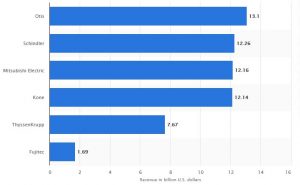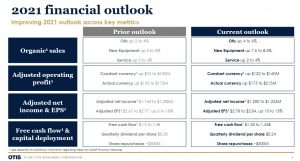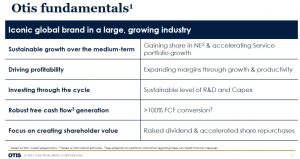Contents
Hidden gems are often lost when part of a conglomerate. This appears to have been the case with Otis Worldwide Corporation (OTIS). For more than 15 years, it was used as a cash cow to fund capital expenditures at United Technologies' two aerospace divisions (now Raytheon Technologies Corporation (RTX)). OTIS is now a stand-alone entity and has recently declared a 20% increase in its quarterly dividend from $0.20/share to $0.24/share. Is it possible OTIS is a dividend aristocrat in its infancy?
A Dividend Aristocrat is a constituent of the S&P 500 that has increased its dividend for at least 25 consecutive years.
One dividend increase certainly does not make OTIS a Dividend Aristocrat. Let's, however, see if OTIS has the potential to eventually become one.
Industry Overview
Based on 2020 Revenue statistics, OTIS is the largest key vendor of elevators and escalators based in the United States, Switzerland, Germany, Finland, and Japan.

Source: Statista
The global elevator and escalator market is anticipated to reach US$142.2B in 2024 and a 7% CAGR during 2020-2024 was projected in early 2020.
Growth in this market is being driven by increasing urbanization, surging aged population, rising construction expenditure and increasing gross domestic product.
The market is expected to face certain challenges which include the high price of installation and lack of a skilled workforce.
The global smart elevator market consists of 3 segments ranked in the following order of dominance:
- modernization;
- new installation; and
- maintenance.
The segments in the global smart elevator market in order of dominance is as follows:
- commercial;
- residential;
- institutional; and
- industrial.
In 2019, the dominant share of the elevator and escalator market was held by the Asia Pacific, EMEA, and Americas regions. The Asia Pacific market is expected to dominate the market in future due to rising public expenditure on infrastructural development in developing countries such as Indonesia, India, China, and the Philippines.
Business Overview
OTIS is organized into the New Equipment and Service segments. In FY2020 the New Equipment segment:
- contributed 42% of Net Sales and 16% of the Operating Profit.
- had Net Sales of $5.4B and an Operating Profit of $0.318B; China represented over half of global New Equipment sales by unit volume.
In FY2020, the Service segment had Net Sales of $7.4B and an Operating Profit of $1.6B. This represents 58% of Net Sales and 84% of the Operating Profit in FY2020.
The Service segment performs maintenance and repair services, as well as modernization services to upgrade elevators and escalators.
OTIS has a high retention rate in its Service segment in developed markets; this means a steady revenue stream even when new installations are hurt by slowdowns.
It has a maintenance portfolio of over 2 million units globally. This includes OTIS equipment manufactured and sold by the company and equipment from other original equipment manufacturers. More than 85% of the company's service portfolio is located in EMEA, North America, Japan, and South Korea.
Major elevator Original Equipment Manufacturers are rolling out digital services. OTIS will benefit from these remotely connected elevator contracts as they will add revenue, increase retention rates, and generate higher margin contributions.
Looking at some of the recent News Releases, such as that dated April 22, 2021, there should be a wave of modernizations in Europe and then in China. This will provide OTIS with the opportunity to sell digital services on the modernization installations.
A good overview of the company and the risk factors can be found in Part 1 of the FY2020 10-K.
Financial Review
Although Exhibit 13 in the FY2020 10-K includes a 5 year summary of financial data (page 39 of 136), the historical OTIS and the stand-alone OTIS are too different to form a proper financial comparison.
OTIS was treated as a cash cow for several years under the United Technologies umbrella. This resulted in under-investment in OTIS. Little money, for example, was spent on important investments like remote electronic monitoring systems which allow for better preventive maintenance and fewer unexpected callouts. This would have improved margins and efficiency.
Starting in ~2016, investments in the business increased to narrow the gap with its peers. This also contributed to a reduction in service attrition rates.
With OTIS now a stand-alone company, it can control its own resources.
Q1 2021 Results
Judging from the Q1 results released April 26, 2021, OTIS appears to be benefiting from being a stand-alone company. It generated $0.585B of GAAP cash flow from operations, $0.541B of free cash flow (Net cash flows provided by operating activities minus Capital Expenditures (page 15 of 16)), and a 380 basis point improvement in Operating Margin.
In addition to the $0.04/share/quarter dividend increase, $0.3B of outstanding shares were repurchased.
FY2021 Guidance
A quick review of the Q1 Earnings Release shows improved guidance in several key metrics.
Risk Assessment
Looking at the schedule of long-term debt (page 82 of 136) in the company's FY2020 10-K, we see no due dates until 2023. OTIS may, however, redeem the notes at its option under certain terms.
Moody's rates the unsecured long-term debt Baa2 and S&P Global rates it BBB. These ratings are identical, are the middle tier of the 'lower medium grade' category, and view an obligor to have ADEQUATE capacity to meet its financial commitments. Adverse economic conditions or changing circumstances, however, are more likely to lead to a weakened capacity of the obligor to meet its financial commitments.
These ratings are satisfactory for my prudent investor profile.
The dividend history is short since the company only became publicly traded on April 3, 2020.
On April 19, 2021, OTIS declared an increase in its $0.20 quarterly dividend to $0.24. Shares closed at $76.27 on April 26th so the new $0.24/share/quarter dividend yields ~1.26%.
Despite the repurchase of $0.3B of issued and outstanding shares, the weighted average number of diluted issued and outstanding shares rose from 433.1 million to 433.7 million (March 31, 2020).
OTIS is still in its infancy as a stand-alone company but I see no reason to think it will not continue to generate strong free cash flow. This bodes well for annual dividend increases and share buybacks. In fact, these are two areas in which OTIS has indicated it intends to create shareholder value.
Valuation
As a long-time United Technologies Corporation shareholder, I received OTIS shares on May 6, 2020, at which time the share price was ~$44. Shares now trade at $76.27 as of April 26, 2021.
Let's have a quick look at the current valuation.
Q1's diluted EPS of $0.71/share is almost the same as the adjusted diluted EPS of $0.72. Adjustments are possible over the next 3 quarters but let's proceed on the basis that adjusted and GAAP earnings will be very similar.
FY2021 adjusted diluted EPS guidance is now $2.78 - $2.84 versus the prior $2.67 - $2.77. Using the current $76.27 share price, the forward adjusted diluted PE range is now ~26.9 - ~27.4. Using a $2.81 mid-point, we arrive at a ~27.14 forward adjusted diluted PE.
Suppose FY2022 adjusted diluted EPS increases 10% - 13% from $2.78 - $2.84 to $3.06 - $3.21. Using the ~$3.14 mid-point and the current $76.27 share price, the forward adjusted diluted PE is ~24.3.
OTIS - A Dividend Aristocrat In Its Infancy? - Final Thoughts
Is OTIS a dividend aristocrat in its infancy? I think so.
It is entirely possible OTIS may acquire small service portfolios to boost the service side of its business. I do not, however, envision major acquisitions because I think it has less financial flexibility than some of its peers due to the debt it incurred in the spin-off from United Technologies.
One significant operating risk is the ability to maintain pricing power and improve retention rates in China. These are much lower than in mature markets as price competition in China is intense. A mitigating factor is that OTIS tries to focus on the higher-end part of the Chinese market. Over time, however, the Chinese market will approach maturity and new installations will represent a lower portion of the market. This will make it increasingly challenging to offset the higher attrition rates with high growth in new installations. This will not be a problem unique to OTIS and all major industry participants will need to become increasingly efficient and/or increasingly price competitive.
OTIS is a company that ticks all the 'right boxes' for me. The company is the largest elevator and escalator industry participant and it has built a recurring stream of income through the Service segment. It has a strong Free Cash Flow track record and I see no reason which this should not continue. I also like that it can retain funds to enhance shareholder value as opposed to what it had to do when it was part of United Technologies. Now, OTIS can manage its own destiny!
My immediate concern, however, is the current valuation. I think the broad market is due for a pullback and envision OTIS's share price will not be immune from any downdraft.
Charlie Munger has stressed the importance of Patience and Discipline to improve investment success. I might have to wait a bit but I think a price below the mid $60s is more reasonable at which to acquire additional OTIS shares.
Stay safe. Stay focused.
I wish you much success on your journey to financial freedom.
Note: Please send any feedback, corrections, or questions to [email protected].
Disclosure: I am long OTIS and RTX in the FFJ Portfolio and in tax-advantaged accounts for which I do not disclose details for confidentiality reasons.
Disclaimer: I do not know your individual circumstances and do not provide individualized advice or recommendations. I encourage you to make investment decisions by conducting your own research and due diligence. Consult your financial advisor about your specific situation.




